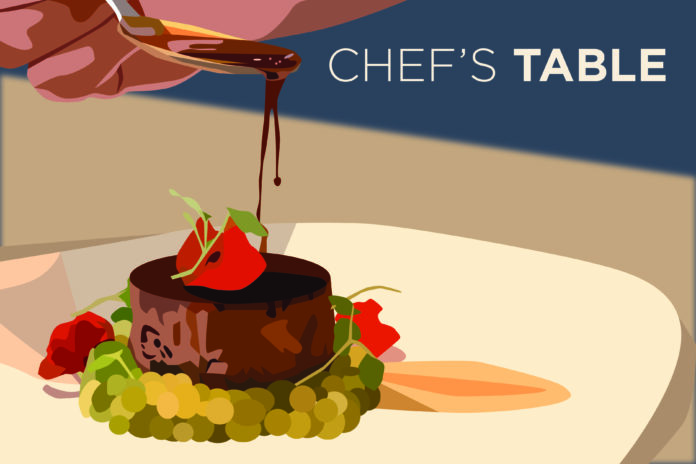Series brings to forefront issues affecting street vendors throughout world
The Netflix original series “Street Food,” created by the creators of “Chef’s Table,” steps away from the Michelin Guide and hits the streets in search of unknown culinary masters. As a celebration of the roots of Asian cuisine, some destinations include Delhi, Seoul, Singapore, Bangkok and Osaka, exploring the culinary delicacies of everyday people.
Like “Chef’s Table,” this spin-off uses the same, slow-motion shots accompanied by suspenseful classical music, but it differs from the elite, white tablecloth restaurants showcased in the first four seasons of “Chef’s Table.” By taking an Anthony Bourdain-style approach, the series features street cooks who represent their culture’s traditional foods.
These hawkers, none of whom went to culinary school, have been cooking the same dishes for fifty years, have secrets they had to learn the hard way and hold a deep respect for the food.
Each episode follows the story of one main cook and how they came to be masters of their trade without professional training. Most of these individuals are elders with extensive knowledge of the ingredients and traditional techniques passed down through generations. The creators of “Street Food” declare these street cooks as not only chefs, but preservers of culture.
Street food developed because many poor people did not have kitchens in their homes. Instead, they depended on street vendors for their meals. These dishes were first made for the working class, but today, the street food scene has evolved to defy class barriers — attracting everyone from young to old and poor to rich, street food is now for everyone.
The chefs featured in “Street Food” not only show how they make food, but also tell their family’s story and exhibit their culture. Nearly all of these hawkers inherited their stands from their families, using traditional methods and family recipes passed down through generations. Authentic dishes are a product of dedication and attention to detail, with only the best surviving the cut-throat nature of street vending. Simply having the recipes and the name is not enough: the success of these chefs comes from extensive knowledge of their craft, tireless work and perseverance.
For some vendors, it was expected they would inherit the family business as a symbol of family honor. Others, however, wanted their children to move away from the grueling and laborious trade. Most street food businesses don’t provide stability, only allowing these workers to make enough money to get by — it is a labor of love, not profit.
Each episode tells a story of hardship, poverty, devastation from natural disasters and family separation, but what keeps the cooks going is their passion for cooking meals for others and putting a smile on people’s faces. Each of the chefs rose to the top of their respective city’s food scenes by breaking new ground and redefining what street food means in the modern day.
For some, like Mbah Satinem in Yogyakarta, Indonesia, this meant keeping dishes constant in an evolving food scene, becoming the last bearer of jajan pasar — a treat made from palm sugar, sticky rice, cassava and coconut. For others, this meant being part of the evolution by adapting, growing and popularizing their dishes, like Jay Fai in Bangkok, Thailand, who created dishes like dry tom yum and her famous crab omelettes which earned her a Michelin Star.
But for all of these cooks, maintaining the integrity of the traditional recipes means using quality, local ingredients. The camera follows them to their local, outdoor markets where they hand-select seafood, produce and spices. It also means sleeping no more than four hours a night and working nonstop every day for years on end. And these hawkers are faced with a new challenge: government regulations in many of the cities which threatens their livelihood and existence.
Thailand’s military government is waging war on street vendors and forcing them off the sidewalks. The Bangkok Metropolitan Administration (BMA) has moved over 20,000 street vendors from nearly 500 locations since 2016.This affects not only the livelihood of the vendors themselves, many of them women, but also the communities that rely on street food for affordable meals.
The cuisine from street food vendors is not a newly explored frontier, but “Street Food” is the first to address the changing political landscape that is threatening the survival of these economies and communities. The success and recognition of these street vendors like Jay Fai represents hope for the future of street food vendors. If the food is good enough, they bring people in on their own terms. “Street Food” has started a global conversation and brought to the forefront threats against street vendors in the hopes of liberating a counter movement.
Food is a tradition passed from generation to generation. Food is nostalgia. Food brings people together. Food is a representation of culture, and media like “Street Food” is a window into that culture, documenting and preserving heritage. This series left me inspired, salivating and hungry to explore the culinary destinations of Asia, not by a Michelin Guide, but by the streets.
Written By: Grace Simmons — arts@theaggie.org





